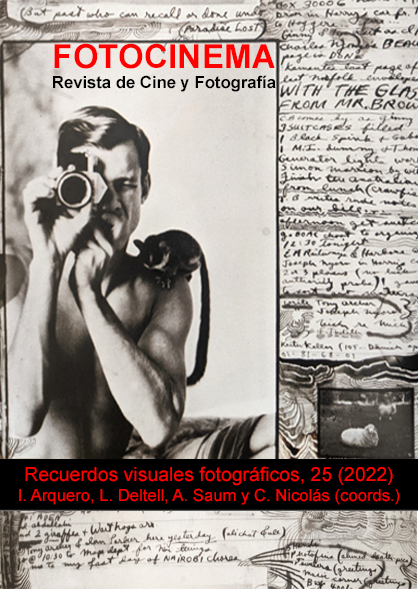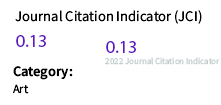Deconstructions and falsifications of visual memory. The coloring of images in the post-truth era
Keywords:
Colorization, Black & White, Photography, Film, Digitization, Post-truthAbstract
In recent years we have witnessed the release of documentaries such as World War II in Color, (Jonathan Martin, 2009), They Shall Not Grow Old (Peter Jackson, 2018) or España en dos trincheras. La Guerra Civil en colores (Francesc Escribano, Lluís Carrizo, 2016), characterized by the colorization of filmic materials originally recorded in black and white. The recent publication of the work El color del tiempo. A New Visual History of the World 1850-1960 (Amaral and Jones, 2021), which includes the publication of 200 photographs of high historical and documentary value, originally in black and white, raises a reflection on the use of color as an expressive and narrative resource in the fields of photography and film. In this paper, we consider that the use of black and white is a discursive option loaded with meanings, which in no case should be interpreted as a lack of photographic expression (Freeman, 2005; Marzal, 2007; Edwards, 2019). It is argued that the fashion for colorization in film and photography should be placed in relation to the current context of the expansion of the so-called deep fake, a technique that decontextualize the production of images.
Downloads
Metrics
Publication Facts
Reviewer profiles N/A
Author statements
Indexed in
-
—
- Academic society
- N/A
- Publisher
- Universidad de Málaga
References
Aguaded-Gómez, I., y Romero-Rodríguez, L. (2015). Mediamorfosis y desinformación en la infoesfera: alfabetización mediática, digital e informacional ante los cambios de hábitos de consumo informativo. Education in the Knowledge Society, 16(1), 44-57. https://doi.org/10.14201/eks20151614457
Amaral, M., y Jones, D. (2021). El color del tiempo. Una historia visual del mundo 1850-1960. Desperta Ferro Ediciones.
Antón, J. (2021). Los muertos parecen más muertos en colores. Recuperado el 20 de julio de 2021 de https://elpais.com/cultura/2021-07-14/los-muertos-parecen-mas-muertos-en-colores.html
Ball, P. (2001). La invención del color. Turner.
Barojek, J. (2015). On Colour Photography in an Extra-Moral Sense. Third Text Journal, 29(3), 221-235. http://dx.doi.org/10.1080/09528822.2015.1106136
Barthes, R. (1989). La cámara lúcida. Paidós.
Baudrillard, J. (1984). Cultura y simulacro. Kairós.
Baudry, J.-L. (1970). Cinéma: Effects idéologiques produits par l´appareil de base. Cinéthique, 7-8.
Baudry, J.-L. (1975). Le dispositif. Communications, n. 23: Psychoanalyse et cinéma. Éditions du Seuil.
Bolter, J. D., y Grusin, R. (2000). Remediation: understanding new media. MIT Press.
Benjamin, W. (1973). Breve historia de la fotografía. Discursos Interrumpidos I. Taurus. (Trabajo original publicado en 1931)
Burch, N. (1987). El tragaluz del infinito. Cátedra.
Cartier-Bresson, H. (2017). Fotografiar del natural. Gustavo Gili.
Comolli, J.-L. (1971-72). Technique et Idéologie. Caméra, perspective et profondeur de champ. Cahiers du cinéma, 229, 230, 231, 233, 234-235 y 236.
Davies, H. (2010). Creative Black & White. Digital Photography Tips & Techniques. Wiley.
Debord, G. (1999). La sociedad del espectáculo. Pre-Textos.
Didi-Huberman, G. (2012). Arde la imagen. Serieve.
Edwards, E. (2019). The Colour of Time: A New History of the World 1859-1960. History of Photography, 43(3), 331-332. https://doi.org/10.1080/03087298.2020.1732059
Flusser, V. (1990). Hacia una filosofía de la fotografía. Editorial Trillas.
Fontcuberta, J. (2016). La furia de las imágenes. Notas sobre la postfotografía. Galaxia Gutenberg.
Freeman, M. (2005). Fotografía digital, blanco y negro. Evergreen.
Frizot, M. (Ed.) (1998). A New History of Photography. Könnemann.
García Rodero, C. (1989). España oculta. Lunwerg.
Gómez Cruz, E. (2012). De la cultura Kodak a la imagen en red. Una etnografía sobre fotografía digital. UOCPress.
Hoffman, T. A. (2011). The Art of Black and White Photography: Techniques for Creating Superb Images in a Digital Workflow. Rocky Nook Inc.
Ledo, M. (2020). El cuerpo y la cámara. Cátedra.
Lister, M. (2007). La imagen fotográfica en la cultura digital. Paidós.
Lemagny, J.-C., y Rouillé, A. (Eds.). (1988). Historia de la fotografía. Martínez Roca.
Mangia, E. (2014). La fotografía: blanco / negro y a color. La evolución de un nuevo medio de percepción. Revista PUCE, 98, 35-54.
Marta-Lazo, C. (2018). El marco teórico de la alfabetización mediática: orígenes, fundamentos y evolución conceptual. En C. Fuente Cobo, C. García Galera, y C. Camilli Trujillo (Eds.), La educación mediática en España: artículos seleccionados (pp. 47-54). Editorial Universitas.
Martin, J., y Colbeck, A. (1989). Handtinting Photography. Amanuens Books Limited.
Marzal Felici, J. (2007). Cómo se lee una fotografía. Interpretaciones de la mirada. Cátedra.
Mitchell, W. J. T. (1994). Picture Theory. Essays on Visual and Verbal Representation. The University of Chicago Press. [Trad. cast. (2009) Teoría de imagen. Ensayos sobre representación verbal y visual. Akal].
Newhall, B. (1983). Historia de la fotografía. Desde sus orígenes hasta nuestros días. Gustavo Gili.
Paterson, Tina (s.a.). Enhanced Memory (Memoria mejorada, https://cutt.ly/iJlOdqP).
Pérez Tornero, J. M. (2020). La gran mediatización I. El tsunami que expropia nuestras vidas. Del confinamiento digital a la sociedad de la distancia. UOCPress.
Ramroop, N. (2017). Five Reasons to Try Black and White Photos. Recuperado el 25 de octubre de 2021 de https://digital-photography-school.com/5-reasons-why-try-black-and-white-photography/
Reina, C. (2022). El color vuelve a la imagen de quien fue el último español superviviente de Mauthausen. Cordópolis. Recuperado de https://cordopolis.eldiario.es/cordoba-hoy/sociedad/color-vuelve-imagen-ultimo-espanol-superviviente-mauthausen_1_8943818.html
Riego, B. (2022). Blog: Historia de las imágenes y sus tecnologías para entender nuestro tiempo. Recuperado el 20 de enero de 2022 de https://bernardoriego.wordpress.com/author/bernardoriego/
Ritchin, F. (2009). After Photography. W. W. Norton & Company, Inc.
Roberts, P. (2008). Cien años de fotografía en color. Electa.
Rouillé, A. (1988). La exploración fotográfica del mundo en el siglo XIX. En J.-C. Lemagny y A. Rouillé, Historia de la fotografía, (pp. 53-59). Ediciones Martínez Roca. ,
Salgado, S. (2013). De ma terre à la terre. Presses de la Renaissance.
Sampedro, V. (2018). Dietética digital. Para adelgazar al gran hermano. Icaria Editorial.
Sassen, S. (2011). Black and White Photography as Theorizing: Seeing What the Eye Cannot See. Sociological Forum, 26(2), 438-443. DOI: 10.1111/j.l573-7861.2011.01251.x
Sontag, S. (1981). Sobre la fotografía. Edhasa.
Sougez, M.-L. (1981). Historia de la fotografía. Cátedra.
Vidal, M. (2013). Diez razones para fotografiar en Blanco y Negro. Recuperado el 25 de octubre de 2021 de https://www.dzoom.org.es/10-razones-para-fotografiar-en-blanco-y-negro/
Vives-Ferrándiz Sánchez, L. (2021). La verdad es hija de la imagen: reflexiones sobre la posverdad en los tiempos del giro visual. adComunica. Revista Científica de Estrategias, Tendencias e Innovación en Comunicación, 22, 27-44. https://doi.org/10.6035/2174-0992.2021.22.3
von Ameluxen, H. (1998). Around the World. Photography and the recording of history. En M. Frizot, The New History of Photography (pp. 148-166). Könneman.
Zavagno, D., y Massironi, M. (2006). Colours in black and white: The depiction of lightness and brightness in achromatic engravings before the invention of photography. Perception, 35, 91-100.
Downloads
Published
How to Cite
Issue
Section
License
All contents published in Fotocinema Revista científica de cine y fotografía are protected under the Creative Commons Attribution-NonCommercial-ShareAlike 4.0 International (CC BY-NC-SA 4.0) license. All about this license is available in the following link: <http://creativecommons.org/licenses/by-nc-sa/4.0>
Users can copy, use, redistribute, share and exhibit publicly as long as:
- The original source and authorship of the material are cited (Journal, Publisher and URL of the work).
- It is not used for comercial purposes.
- The existence of the license and its especifications are mentioned.
There are two sets of authors’ rights: moral and property rights. Moral rights are perpetual prerogatives, unrenounceable, not-transferable, unalienable, imprescriptible and inembargable. According to authors’ rights legislation, Fotocinema. Revista científica de cine y fotografía recognizes and respects authors moral rights, as well as the ownership of property rights, which will be transferred to University of Malaga in open access. The property rights are referred to the benefits that are gained by the use or the dissemination of works. Fotocinema. Revista científica de cine y fotografía is published in an open access form and it is exclusively licenced by any means for doing or authorising distribution, dissemination, reproduction, , adaptation, translation or arrangement of works.
Authors are responsable for obtaining the necessary permission to use copyrighted images.










13.png)



